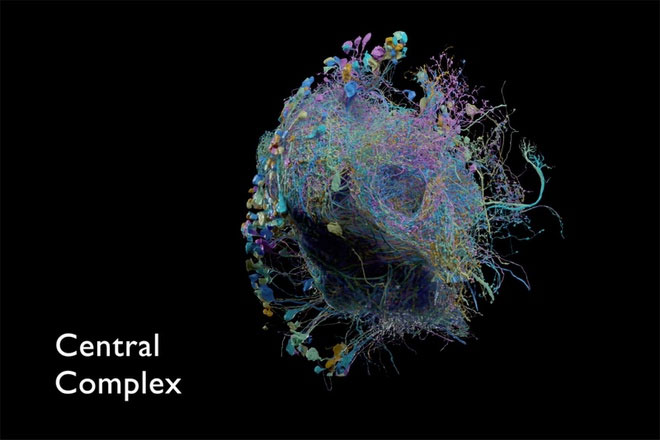The most detailed brain nerve map has just been published
Scientists from Google and the FlyEM research team at the Janelia Institute have published the most detailed animal brain neural network map ever.
This is a new milestone in the research of brain neural network map using scanning technology (also called connectomic learning) . A new field of neuroscience, focusing on studying the connection between brain parts and in parts of the brain.

A part of the fruit fly neural network, a result of research from Google and the Janelia Institute.(Photo: Google, FlyEM).
Sharing with The Verge, Mark Humphries, a neuroscientist at the University of Nottingham, affirmed that connectomic is a wonderful field and a resource for many scientists. Although it cannot solve urgent problems, it will open up interesting mysteries.
The 3D brain nerve map created by Google and FlyEM is the latest scientific and technical achievement, a product of a combination of humans and machines.
Fruit flies are scientists' favorite experiments because they have a simple brain structure but still have the ability to control and perform complex behaviors such as inviting mates.
First, the researchers cut the brain of vinegar into 20 micron thick layers (1/3 of the width of a human hair). They built images by beating each layer of the brain by electron flow from scanning electron microscopes. The data is then used to create 3D images of 50 trillion 3-dimensional pixels (voxels), processed by computer algorithms.
In addition to the help of AI, researchers have spent hundreds of thousands of hours identifying each of the 20 million synapses, along with virtual reality glasses and 3D editing software to ensure images are rendered. exactly.
Even taking so long, they only produce one-third of the fruit fly's brain. There is only one organism that has been created a complete brain neural network map, the nematode Caenorhabditis elegans.
The 3D image shows 20 million synapses connecting more than 25,000 nerve cells of a third of a fruit fly's brain.

Although it takes a lot of time and effort, this is only a small part of the secrets of animal brains, including humans.(Photo: Google, FlyEM).
A fruit fly brain contains about 100,000 neurons, while the human brain is 86 billion neurons. This suggests that a great deal of research effort is still needed to create a complete map of the human brain.
Since its inception, connectomic has received mixed opinions. Supporters argue that the field helps connect physical parts of the brain with specific behaviors - the goal of neuroscience. While the opposing team argues that it has not made any major breakthrough. Neurological mapping is time-consuming, and resources can be used for other purposes.
However, Joshua Vogelstein, a biomedical engineer and co-founder of the Open Connectome project, thinks that this step will be of great help to us in the next few decades.
All research results are publicly posted by Google and FlyEM for everyone to follow. They also plan to share documents related to the project for those who want to conduct research.
- New brain map reveals 97 unknown areas
- Reveals the world's first human brain map
- Manufacturing brain modulators for people with Parkinson's
- Detecting brain cells regulating memory
- Published a map of human brain
- Scientists have discovered 97 regions in the brain that have never been known before
- Sleep apnea causes brain damage
- Detailed publication of the map of human gene variants
- Memory of the digestive system helps us remember where we used to eat
- Smart dust - Micro sensor implanted in the brain, real-time monitoring
- Technology put straight into the brain type Matrix
- Sex helps the brain grow faster
- How to treat nerve damage with stem cells
- Neurons continue to grow where the brain matures
 13 causes of non-itchy rash
13 causes of non-itchy rash How the mouse with human ears changed the world?
How the mouse with human ears changed the world? The truth about 'fried rice syndrome!
The truth about 'fried rice syndrome! What is dental implant?
What is dental implant?